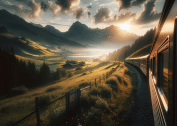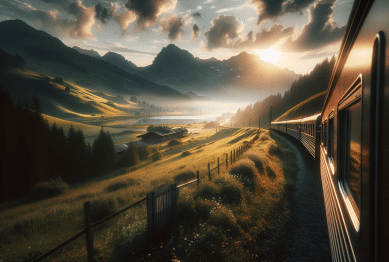Discover how scenic train journeys around the world offer sustainable travel options and a unique way to see breathtaking landscapes. This guide reveals hidden rail routes, sleeper train experiences, and tips for making the most out of train vacations, all while embracing eco-friendly tourism.
The Enduring Appeal of Train Journeys
Vast mountain ranges, vibrant cities, and tranquil countryside landscapes can be enjoyed from the comfort of a train. Train vacations continue to captivate travelers who seek something more immersive than air travel offers. One reason train travel remains so popular is the blend of comfort and adventure. Whether venturing across continents or exploring local destinations, trains provide a unique sense of connection to the land and its people.
Scenic rail routes, like the famed Trans-Siberian Railway or the Venice Simplon-Orient-Express, create unforgettable memories. Each ticket purchased unlocks not just a destination, but an entire journey filled with shifting views and cultural encounters. Travelers often find themselves captivated by the ever-changing scenery just outside their window. For those looking to slow down and savor the world, these journeys offer the perfect escape.
Modern amenities aboard sleeper trains and luxury railcars blend comfort with nostalgia. Onboard dining cars serve local delicacies, while sleeping berths ensure restful nights. Rail vacations attract those interested in eco-friendly tourism as trains are recognized for their comparatively lower carbon footprint compared to other transport options (Source: https://www.epa.gov/greenvehicles/fast-facts-transportation-greenhouse-gas-emissions).
Why Sustainable Train Travel Is Gaining Momentum
Sustainability has risen to the forefront of travel planning. Trains, which use less energy per passenger than planes or cars, have become a popular choice for eco-conscious travelers. According to environmental experts, railways significantly reduce greenhouse gas emissions, making them a preferred mode for those wanting to minimize their impact (Source: https://www.unece.org/fileadmin/DAM/trans/doc/2019/wp6/SC.2_2019_7e.pdf).
Many countries across Europe and Asia are embracing train tourism, modernizing networks and introducing solar-powered trains. Travelers can support conservation efforts simply by choosing rail over air for long distances. The result? Less pollution and a chance to enjoy landscapes at a slower, more natural pace. Rail operators also increasingly focus on waste reduction and recycling to push sustainability further.
The sustainability focus extends to local economies. Train routes often connect rural areas with urban centers, providing a steady influx of visitors to support small businesses and artisans. For many, sustainable travel is not just about the planet but also people and culture. Learning how railway trips benefit both is transforming the way people plan adventures.
Scenic Rail Routes Worth Adding to Your Bucket List
The list of scenic train routes around the world is endless, but a few journeys stand out for their beauty. Imagine gliding through the Alps on the Glacier Express, winding along Australia’s coast on the Indian Pacific, or experiencing the lush valleys along Canada’s Rocky Mountaineer. These journeys invite travelers to witness landscapes otherwise inaccessible by road or foot.
Each route offers something distinct: The Bernina Express passes through UNESCO-listed sites, while Norway’s Flåm Railway showcases waterfalls and fjords. In Japan, the Shinkansen gives high-speed comfort paired with views of Mount Fuji. Many of these routes integrate cultural stops and local flavors, so the journey is complemented by regional experiences and stories. Some even feature panoramic windows for maximum sightseeing comfort.
Securing a seat on these famous routes often requires advance research. Prices and schedules can vary widely, and some luxury train journeys are booked months ahead. Flexible travel dates and midweek departures often increase availability and lower costs. For travelers using interrail passes or global rail networks, planning ahead ensures seamless connections between multiple cities or countries.
Sleeper Trains: Combining Comfort with Adventure
Sleeper trains transform overnight travel into an experience in itself. Rolling beds, cozy cabins, and soft lighting make these journeys restful and memorable. Travelers can board a train in one city and wake up in another, all while skipping the hassle of airport security or traffic jams. It’s a resourceful way to maximize both budget and time—hotel and transportation combined.
Different trains offer varying levels of privacy and comfort. Shared couchettes are affordable, while private compartments add space and quiet. European sleeper services on routes like Paris-Vienna and the Caledonian Sleeper between London and Scotland are seeing a revival, in part because of their blend of convenience and nostalgia (Source: https://www.seat61.com/sleepers-and-couchettes.htm).
Planning ahead can help travelers choose the features that matter most, from ensuite bathrooms to gourmet meals. Bringing snacks and entertainment, or seeking out communal lounge cars, can make long journeys more enjoyable. Those traveling with family or in groups find sleeper trains especially appealing because everyone shares the adventure but also gets rest between destinations. The social atmosphere can turn strangers into friends by the next stop.
Tips for Planning a Memorable Rail Vacation
Effective planning makes all the difference for rail vacations. Start by researching route options, reading reviews, and comparing amenities before booking. Many major lines offer discounts for youth, seniors, or groups. Passes like Eurail make extensive itineraries more affordable and flexible for visitors planning to hop between countries.
Check luggage policies, as some trains have limits on size or weight. Packing light ensures easy boarding and less stress when navigating terminals. Accessible compartments and family-friendly seating are also worth checking before departure if traveling with children or mobility needs. For those wanting a taste of local culture, many trains collaborate with regional culinary teams, so local dishes feature in onboard menus.
Learning a few words in the local language or reading up on traditions enriches every stop along the route. Rail stations are more than transit points—they often serve as historic landmarks or cultural attractions. By arriving early, travelers can explore architecture and nearby markets before boarding. Experiences like these make the moments between destinations just as rewarding as any view from the window.
Why Rail Travel Is Making a Comeback Globally
Rail travel experienced a revival as travelers rediscover the joys of slow, scenic journeys. Health-conscious travelers favor rail for its spacious cabins and the ability to move around more freely than on planes. The allure of fewer crowds and simpler boarding processes attracts those looking to minimize stress.
This renewed popularity is also thanks to innovation—high-speed networks, Wi-Fi connectivity, and sustainability efforts make modern rail appealing. The experience is customizable, from choosing basic seating to luxury cabins with private staff. The comfort and ambiance of train travel set it apart from buses or budget airlines.
Travel communities online share tips and photos, creating excitement around unique rail adventures. Influencers detail favorite sleeper trains, beautiful stations, and lesser-known regional journeys. With railways investing in both customer experience and green technology, industry experts predict more new routes and expanded networks in the future (Source: https://www.uic.org/com/enews/article/highlights-of-global-rail-market).
References
1. U.S. Environmental Protection Agency. (n.d.). Fast facts on transportation greenhouse gas emissions. Retrieved from https://www.epa.gov/greenvehicles/fast-facts-transportation-greenhouse-gas-emissions
2. United Nations Economic Commission for Europe. (2019). Railways and sustainable development goals. Retrieved from https://www.unece.org/fileadmin/DAM/trans/doc/2019/wp6/SC.2_2019_7e.pdf
3. Seat61. (n.d.). Sleepers & couchettes guide. Retrieved from https://www.seat61.com/sleepers-and-couchettes.htm
4. Eurail. (n.d.). Plan your rail adventure. Retrieved from https://www.eurail.com/en/plan-your-trip
5. Rocky Mountaineer. (n.d.). Train routes in Canada. Retrieved from https://www.rockymountaineer.com/train-routes
6. International Union of Railways. (n.d.). Highlights of the global rail market. Retrieved from https://www.uic.org/com/enews/article/highlights-of-global-rail-market









